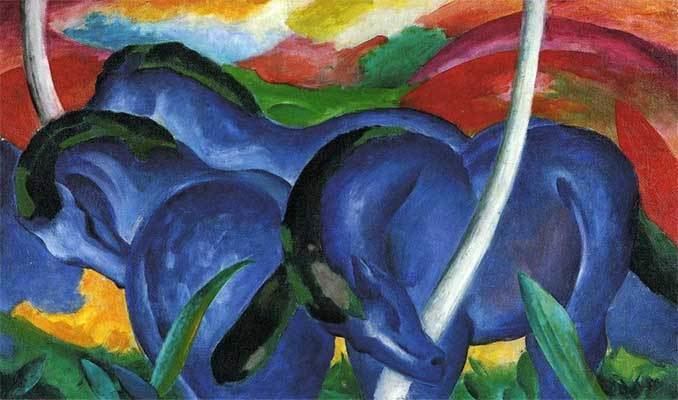 | ||
Expressionism
Expressionism was a modernist movement, initially in poetry and painting, originating in Germany at the beginning of the 20th century. Its typical trait is to present the world solely from a subjective perspective, distorting it radically for emotional effect in order to evoke moods or ideas. Expressionist artists sought to express the meaning of emotional experience rather than physical reality.
Contents
- Expressionism
- Degenerate art 1993 the nazis vs expressionism
- Origin of the term
- Expressionist visual artists
- Expressionist groups of painters
- In other arts
- Dance
- Sculpture
- Cinema
- Journals
- Drama
- Poetry
- Prose
- Music
- Architecture
- References
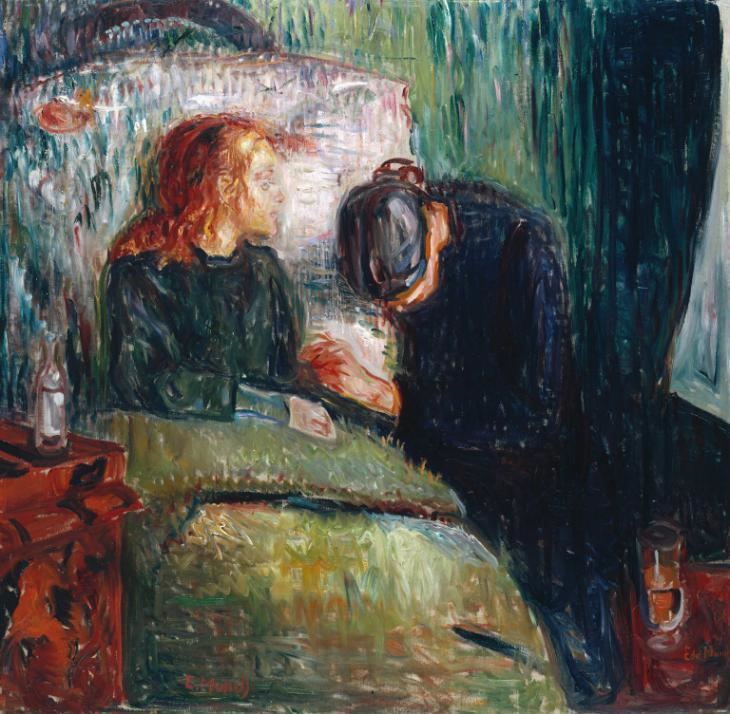
Expressionism was developed as an avant-garde style before the First World War. It remained popular during the Weimar Republic, particularly in Berlin. The style extended to a wide range of the arts, including expressionist architecture, painting, literature, theatre, dance, film and music.
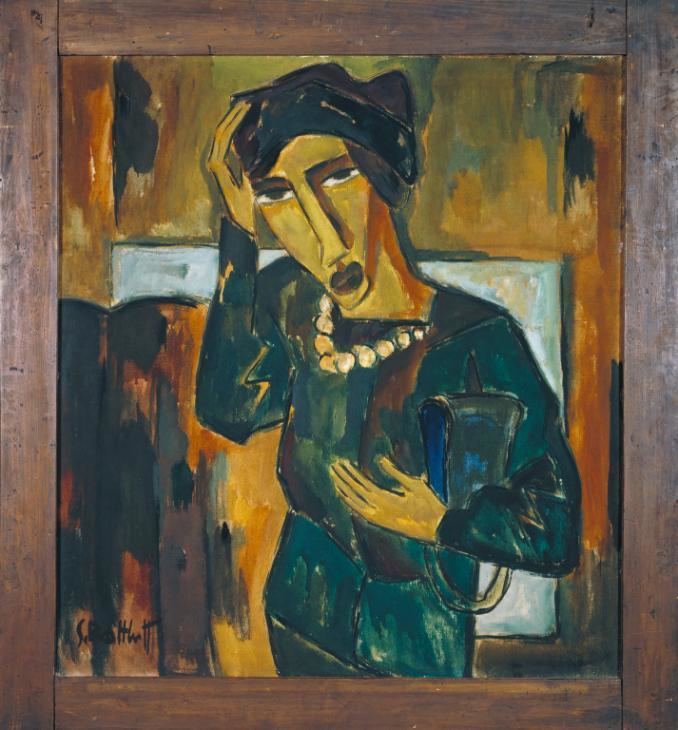
The term is sometimes suggestive of angst. In a general sense, painters such as Matthias Grünewald and El Greco are sometimes termed expressionist, though in practice the term is applied mainly to 20th-century works. The Expressionist emphasis on individual perspective has been characterized as a reaction to positivism and other artistic styles such as Naturalism and Impressionism.
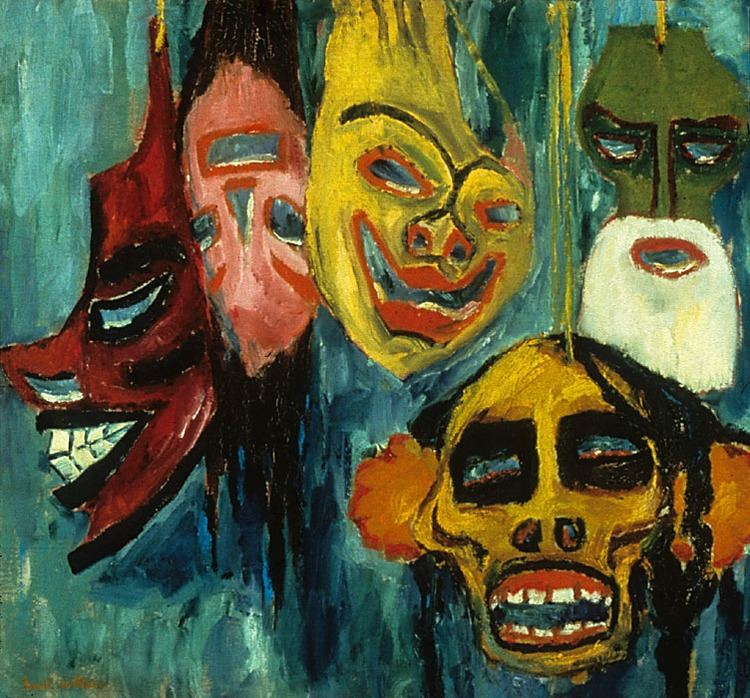
Degenerate art 1993 the nazis vs expressionism
Origin of the term
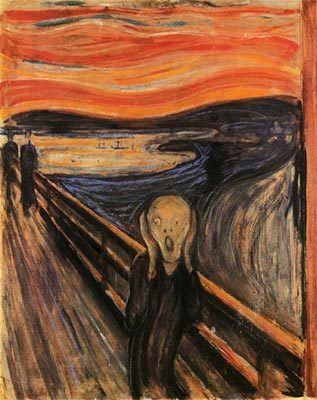
While the word expressionist was used in the modern sense as early as 1850, its origin is sometimes traced to paintings exhibited in 1901 in Paris by an obscure artist Julien–Auguste Hervé, which he called Expressionismes. Though an alternate view is that the term was coined by the Czech art historian Antonin Matějček in 1910, as the opposite of impressionism: "An Expressionist wishes, above all, to express himself... (an Expressionist rejects) immediate perception and builds on more complex psychic structures... Impressions and mental images that pass through mental peoples soul as through a filter which rids them of all substantial accretions to produce their clear essence [...and] are assimilated and condense into more general forms, into types, which he transcribes through simple short-hand formulae and symbols."
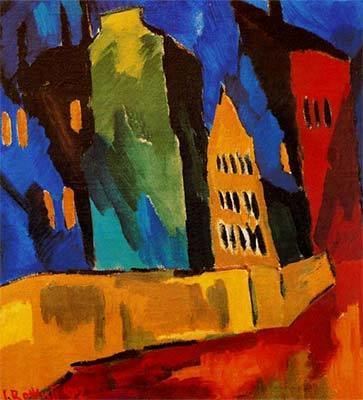
Important precursors of Expressionism were: the German philosopher Friedrich Nietzsche (1844–1900), especially his philosophical novel Thus Spoke Zarathustra (1883–92); the later plays of the Swedish dramatist August Strindberg (1849–1912), including the trilogy To Damascus 1898–1901, A Dream Play (1902), The Ghost Sonata (1907); Frank Wedekind (1864–1918), especially the "Lulu" plays Erdgeist (Earth Spirit) (1895) and Die Büchse der Pandora (Pandora's Box) (1904); the American poet Walt Whitman (1819–92): Leaves of Grass (1855–91); the Russian novelist Fyodor Dostoevsky (1821–81); Norwegian painter Edvard Munch (1863–1944); Dutch painter Vincent van Gogh (1853–90); Belgian painter James Ensor (1860–1949); Sigmund Freud (1856–1939).

In 1905, a group of four German artists, led by Ernst Ludwig Kirchner, formed Die Brücke (the Bridge) in the city of Dresden. This was arguably the founding organization for the German Expressionist movement, though they did not use the word itself. A few years later, in 1911, a like-minded group of young artists formed Der Blaue Reiter (The Blue Rider) in Munich. The name came from Wassily Kandinsky's Der Blaue Reiter painting of 1903. Among their members were Kandinsky, Franz Marc, Paul Klee, and Auguste Macke. However, the term Expressionism did not firmly establish itself until 1913. Though mainly a German artistic movement initially and most predominant in painting, poetry and the theatre between 1910–30, most precursors of the movement were not German. Furthermore, there have been expressionist writers of prose fiction, as well as non-German speaking expressionist writers, and, while the movement had declined in Germany with the rise of Adolf Hitler in the 1930s, there were subsequent expressionist works.
Expressionism is notoriously difficult to define, in part because it "overlapped with other major 'isms' of the modernist period: with Futurism, Vorticism, Cubism, Surrealism and Dada." Richard Murphy also comments: "the search for an all-inclusive definition is problematic to the extent that the most challenging expressionists such as Kafka, Gottfried Benn and Döblin were simultaneously the most vociferous "anti-expressionists."
What, however, can be said, is that it was a movement that developed in the early twentieth-century mainly in Germany in reaction to the dehumanizing effect of industrialization and the growth of cities, and that "one of the central means by which expressionism identifies itself as an avant-garde movement, and by which it marks its distance to traditions and the cultural institution as a whole is through its relationship to realism and the dominant conventions of representation." More explicitly: that the expressionists rejected the ideology of realism.
The term refers to an "artistic style in which the artist seeks to depict not objective reality but rather the subjective emotions and responses that objects and events arouse within a person." It is arguable that all artists are expressive but there are many examples of art production in Europe from the 15th century onward which emphasize extreme emotion. Such art often occurs during times of social upheaval and war, such as the Protestant Reformation, German Peasants' War, Eighty Years' War between the Spanish and the Netherlands, when the extreme violence, much directed at civilians was represented in propagandist popular prints, often unimpressive aesthetically, but with the capacity to arouse extreme emotions in the viewer.
Expressionism has been likened to Baroque by critics such as art historian Michel Ragon and German philosopher Walter Benjamin. According to Alberto Arbasino, a difference between the two is that "Expressionism doesn't shun the violently unpleasant effect, while Baroque does. Expressionism throws some terrific 'fuck yous', Baroque doesn't. Baroque is well-mannered."
Expressionist visual artists
Some of the style's main visual artists of the early 20th century were:
Expressionist groups of painters
The style originated principally in Germany and Austria. There were a number of groups of expressionist painters, including Der Blaue Reiter and Die Brücke. Der Blaue Reiter (The Blue Rider, named for a magazine) was based in Munich and Die Brücke was based originally in Dresden (although some members later relocated to Berlin). Die Brücke was active for a longer period than Der Blaue Reiter, which was only together for a year (1912). The Expressionists had many influences, among them Edvard Munch, Vincent van Gogh, and African art. They were also aware of the work being done by the Fauves in Paris, who influenced Expressionism's tendency toward arbitrary colours and jarring compositions. In reaction and opposition to French Impressionism, which emphasized the rendering of the visual appearance of objects, Expressionist artists sought to portray emotions and subjective interpretations. It was not important to reproduce an aesthetically pleasing impression of the artistic subject matter, they felt, but rather to represent vivid emotional reactions by powerful colours and dynamic compositions. Kandinsky, the main artist of Der Blaue Reiter group, believed that with simple colours and shapes the spectator could perceive the moods and feelings in the paintings, a theory that encouraged him towards increased abstraction.
The ideas of German expressionism influenced the work of American artist Marsden Hartley, who met Kandinsky in Germany in 1913. In late 1939, at the beginning of World War II, New York City received a great number of major European artists. After the war, Expressionism influenced many young American artists. Norris Embry (1921–1981) studied with Oskar Kokoschka in 1947 and during the next 43 years produced a large body of work in the Expressionist tradition. Norris Embry has been termed "the first American German Expressionist". Other American artists of the late 20th and early 21st century have developed distinct styles that may be considered part of Expressionism. Another prominent artist who came from the German Expressionist "school" was Bremen-born Wolfgang Degenhardt. After working as a commercial artist in Bremen, he migrated to Australia in 1954 and became quite well known in the Hunter Valley region.
American Expressionism and American Figurative Expressionism, particularly the Boston figurative expressionism, were an integral part of American modernism around the Second World War.
Major figurative Boston Expressionists included: Karl Zerbe, Hyman Bloom, Jack Levine, David Aronson. The Boston figurative Expressionists post World War II were increasingly marginalized by the development of abstract expressionism centered in New York City.
After World War II, figurative expressionism influenced worldwide a large number of artists and styles. Thomas B. Hess wrote that "the ‘New figurative painting’ which some have been expecting as a reaction against Abstract Expressionism was implicit in it at the start, and is one of its most lineal continuities."
In other arts
The Expressionist movement included other types of culture, including dance, sculpture, cinema and theatre.
Dance
Exponents of expressionist dance included Mary Wigman, Rudolf von Laban, and Pina Bausch.
Sculpture
Some sculptors used the Expressionist style, as for example Ernst Barlach. Other expressionist artists known mainly as painters, such as Erich Heckel, also worked with sculpture.
Cinema
There was an Expressionist style in German cinema, important examples of which are Robert Wiene's The Cabinet of Dr. Caligari (1920), The Golem: How He Came into the World (1920), Fritz Lang's Metropolis (1927) and F. W. Murnau's Nosferatu, a Symphony of Horror (1922) and The Last Laugh (1924). The term "expressionist" is also sometimes used to refer to stylistic devices thought to resemble those of German Expressionism, such as Film Noir cinematography or the style of several of the films of Ingmar Bergman. More generally, the term expressionism can be used to describe cinematic styles of great artifice, such as the technicolor melodramas of Douglas Sirk or the sound and visual design of David Lynch's films.
Journals
Two leading Expressionist journals published in Berlin were Der Sturm, published by Herwarth Walden starting in 1910, and Die Aktion, which first appeared in 1911 and was edited by Franz Pfemfert. Der Sturm published poetry and prose from contributors such as Peter Altenberg, Max Brod, Richard Dehmel, Alfred Döblin, Anatole France, Knut Hamsun, Arno Holz, Karl Kraus, Selma Lagerlöf, Adolf Loos, Heinrich Mann, Paul Scheerbart, and René Schickele, and writings, drawings, and prints by such artists as Kokoschka, Kandinsky, and members of Der blaue Reiter.
Drama
Oskar Kokoschka's 1909 playlet, Murderer, The Hope of Women is often termed the first expressionist drama. In it, an unnamed man and woman struggle for dominance. The man brands the woman; she stabs and imprisons him. He frees himself and she falls dead at his touch. As the play ends, he slaughters all around him (in the words of the text) "like mosquitoes." The extreme simplification of characters to mythic types, choral effects, declamatory dialogue and heightened intensity all would become characteristic of later expressionist plays. The German composer Paul Hindemith created an operatic version of this play, which premiered in 1921.
Expressionism was a dominant influence on early 20th-century German theatre, of which Georg Kaiser and Ernst Toller were the most famous playwrights. Other notable Expressionist dramatists included Reinhard Sorge, Walter Hasenclever, Hans Henny Jahnn, and Arnolt Bronnen. Important precursors were the Swedish playwright August Strindberg and German actor and dramatist Frank Wedekind. During the 1920s, Expressionism enjoyed a brief period of popularity in American theatre, including plays by Eugene O'Neill (The Hairy Ape, The Emperor Jones and The Great God Brown), Sophie Treadwell (Machinal) and Elmer Rice (The Adding Machine).
Expressionist plays often dramatise the spiritual awakening and sufferings of their protagonists. Some utilise an episodic dramatic structure and are known as Stationendramen (station plays), modeled on the presentation of the suffering and death of Jesus in the Stations of the Cross. August Strindberg had pioneered this form with his autobiographical trilogy To Damascus. Theses plays also often dramatise the struggle against bourgeois values and established authority, frequently personified by the Father. In Sorge's The Beggar, (Der Bettler), for example, the young hero's mentally ill father raves about the prospect of mining the riches of Mars and is finally poisoned by his son. In Bronnen's Parricide (Vatermord), the son stabs his tyrannical father to death, only to have to fend off the frenzied sexual overtures of his mother.
In Expressionist drama, the speech is either expansive and rhapsodic, or clipped and telegraphic. Director Leopold Jessner became famous for his expressionistic productions, often set on stark, steeply raked flights of stairs (having borrowed the idea from the Symbolist director and designer, Edward Gordon Craig).
German expressionist playwrights:
Playwrights influenced by Expressionism:
Poetry
Among the poets associated with German Expressionism were:
Other poets influenced by expressionism:
Prose
In prose, the early stories and novels of Alfred Döblin were influenced by Expressionism, and Franz Kafka is sometimes labelled an Expressionist. Some further writers and works that have been called Expressionist include:
Music
The term expressionism "was probably first applied to music in 1918, especially to Schoenberg", because like the painter Kandinsky he avoided "traditional forms of beauty" to convey powerful feelings in his music. Arnold Schoenberg, Anton Webern and Alban Berg, the members of the Second Viennese School, are important Expressionists (Schoenberg was also an expressionist painter). Other composers that have been associated with expressionism are Krenek (the Second Symphony), Paul Hindemith (The Young Maiden), Igor Stravinsky (Japanese Songs), Alexander Scriabin (late piano sonatas) (Adorno 2009, 275). Another significant expressionist was Béla Bartók in early works, written in the second decade of the 20th-century, such as Bluebeard's Castle (1911), The Wooden Prince (1917), and The Miraculous Mandarin (1919). Important precursors of expressionism are Richard Wagner (1813–83), Gustav Mahler (1860–1911), and Richard Strauss (1864–1949).
Theodor Adorno describes expressionism as concerned with the unconscious, and states that "the depiction of fear lies at the centre" of expressionist music, with dissonance predominating, so that the "harmonious, affirmative element of art is banished" (Adorno 2009, 275–76). Erwartung and Die Glückliche Hand, by Schoenberg, and Wozzeck, an opera by Alban Berg (based on the play Woyzeck by Georg Büchner), are examples of Expressionist works. If one were to draw an analogy from paintings, one may describe the expressionist painting technique as the distortion of reality (mostly colors and shapes) to create a nightmarish effect for the particular painting as a whole. Expressionist music roughly does the same thing, where the dramatically increased dissonance creates, aurally, a nightmarish atmosphere.
Architecture
In architecture, two specific buildings are identified as Expressionist: Bruno Taut's Glass Pavilion of the Cologne Werkbund Exhibition (1914), and Erich Mendelsohn's Einstein Tower in Potsdam, Germany completed in 1921. The interior of Hans Poelzig's Berlin theatre (the Grosse Schauspielhaus), designed for the director Max Reinhardt, is also cited sometimes. The influential architectural critic and historian Sigfried Giedion, in his book Space, Time and Architecture (1941), dismissed Expressionist architecture as a part of the development of functionalism. In Mexico, in 1953, German émigré Mathias Goeritz, published the Arquitectura Emocional ("Emotional Architecture") manifesto with which he declared that "architecture's principal function is emotion". Modern Mexican architect Luis Barragán adopted the term that influenced his work. The two of them collaborated in the project Torres de Satélite (1957–58) guided by Goeritz's principles of Arquitectura Emocional. It was only during the 1970s that Expressionism in architecture came to be re-evaluated more positively.
